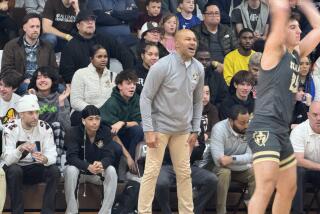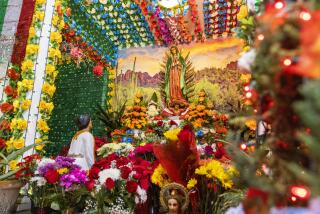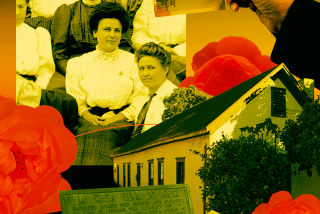Man With a Mission
MISSION HILLS — There was no way for Father Fermin Lasuen to know that a vast city would burgeon out of the brush and parched hills he looked on when he arrived in this valley 200 years ago.
There was no way for the Spanish priest to know, as he began laying adobe bricks for the Mission San Fernando Rey de Espana in 1797, that he was also laying the foundation for the San Fernando Valley of today. In September, the Valley will mark the 200th anniversary of the day Lasuen inaugurated California’s 17th mission by raising a large cross and saying Mass.
Church officials and the San Fernando Valley Convention and Visitors Bureau want to recognize the day with more than a Mass this time but are struggling with how best to do it.
They have talked about a street fair or “gala” dinner and have even toyed with the idea of inviting one of the members of Spain’s royal family to be master of ceremonies. Nothing has been decided.
What is certain is that the mission played a pivotal role in the region’s history and is worthy of celebration.
“There will definitely be some kind of celebration,” said Los Angeles City Councilman Richard Alarcon, who represents the area. “It’s still being decided what that will be but it’s going to happen.”
Alarcon used to play near the mission as a boy; his sister was married there. Recently, he helped organize the volunteer group that restored the Memory Garden in Brand Park, once mission property. He said his office is looking forward to helping in the celebration.
“The mission is one of the pearls of the San Fernando Valley,” he said. “It speaks to the history of the Valley and we need to know our past in order to move into our future.”
*
But right now, a Mass is all that is planned. Msgr. Francis J. Weber, the mission’s director, said Cardinal Roger M. Mahony, archbishop of the Los Angeles Diocese, will officiate at the Mass in September.
Weber said the mission will also be celebrating the restoration of the mission’s Convento building, which was almost destroyed by the 1994 Northridge earthquake. The restoration work is expected to be completed in March.
Weber ruled out a street fair or anything like it for the bicentennial because of the red tape involved. “It has become such a pain in the neck to get all the licenses you need to sell food,” Weber said.
Joan McClellan, executive director of the Convention and Visitors Bureau, said that organization wants to to give the mission a worthy party. “This will show people that the Valley is rich in history,” McClellan said. “The mission is a huge part of that.”
About 25 years ago, the city of San Gabriel staged a weeklong celebration of its mission’s 200th anniversary and, according to Helen Nelson, the mission’s curator, there was a large interest in that celebration.
She said 1,000 volunteers helped with a 350-person dinner party, sold a commemorative book and staged an outdoor Mass attended by more than 650 people.
“It’s a special time, a time to remember how California was created,” Nelson said. “We had a lot of interest and we had a lot of people want to get involved.”
Weber said that San Gabriel Mission had a parish and the San Fernando Mission doesn’t, meaning there are not enough people to do the work for the latter’s celebration.
Although the Valley had long been inhabited by Native Americans, the mission was the first settlement established in the area by Europeans.
It started when Father Junipero Serra was chosen by the king of Spain to build settlements along the California coast in order to claim the territory. Serra planned to build missions a day’s walk from one another along the 650-mile El Camino Real or the Royal Highway.
Lasuen selected the site of the San Fernando Mission, today near San Fernando Mission and Brand boulevards, because there was more water available and the Native Americans in the area were friendly. Those natives helped build the mission; 2,000 were buried in its cemetery.
Before the priests abandoned it in 1835, the mission was home to a successful cattle ranch and vineyard. In later years, it was an army barracks, a hotel and a pig farm, among other things. The mission again became a working church in 1923. Its chapel was destroyed in the 1971 Sylmar earthquake and was rebuilt.
The mission technically sits within Mission Hills, not the nearby “mission city” of San Fernando.
“It is part of our history as a state and a nation,” said Maxine Zewiey, a member of the Mission Hills Chamber of Commerce. “It’s important because it was here first, survived earthquakes and other natural disasters and is still here with us.”
More to Read
Sign up for Essential California
The most important California stories and recommendations in your inbox every morning.
You may occasionally receive promotional content from the Los Angeles Times.










